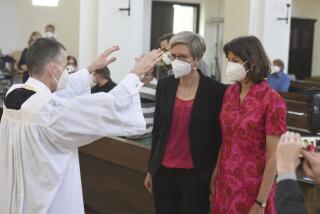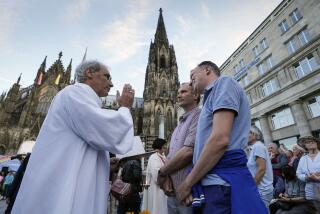With the Blessing of the Church? : Religion: Early rituals sanctioned same-sex unions, a new book says. Its publication is already causing a stir.
- Share via
Did the Roman Catholic church ever bless homosexual unions in ritual ceremonies resembling the sacrament of marriage? The question, explosive by nature and certain to excite ideological reflexes among gay rights advocates and their opponents, has acquired new urgency this week with the publication of Yale University history professor John Boswell’s latest book on human sexuality and the church.
“Same-Sex Unions in Premodern Europe” (Villard Books) asserts that from the 8th to the 18th Centuries, the Catholic church sanctioned same-sex unions and offered ceremonies complete with prayers for the couple’s union, Holy Communion and rubrics directing the couple to kiss a book of the Gospel, the priest and one another.
Publication of the book--and installments of the “Doonesbury” cartoon strip that touch on Boswell’s findings--are already causing a stir within the Roman Catholic Church in the United States and in Eastern Orthodoxy. The “Doonesbury” strips will be published today through Saturday in The Times and other newspapers.
Although “Doonesbury” creator Garry Trudeau refers to the Catholic church in the strip as blessing same-sex unions, most of the Boswell claims point to rituals and practices associated with Eastern Orthodoxy, which arose among early Christians in Greece and Eastern Europe, rather than the Western Christians in Rome.
The cartoon also says that “homosexuality is, of course, a particularly egregious sin before God.” Actually, Roman Catholic teaching holds that a homosexual orientation is not in itself sinful. But any sexual activity outside a heterosexual marriage is considered sinful.
Boswell bases his controversial conclusion on a 12-year study of 55 ancient manuscripts, mainly in Greek, that he says point unmistakably to an attitude of tolerance and charity toward homosexuality among some earlier Christians, far different than the theological polemics that tear at the church today.
His book is also likely to fuel an ongoing debate within some old-line Protestant denominations, among them the Evangelical Lutheran Church in America and the Episcopal Church, over whether to allow same-sex marriages of committed monogamous partners--and to direct that authorized ceremonies be written to sanctify such unions. A related issue in both the Roman Catholic Church and old-line Protestant denominations is whether to ordain homosexuals as clergy.
Boswell’s findings are not only taken seriously by those likely to be pleased with his conclusions, but by detractors who say they do not underestimate his role in helping to shape the continuing debate within the churches over sexual morality.
Boswell won acclaim in 1980 with the publication of his first book, “Christianity, Social Tolerance and Homosexuality.” A review in the New York Times called it revolutionary and said it set “a standard of excellence” in scholarship. It won the American Book Award for history.
That book provided a major intellectual framework for the drive by gay men and lesbians for spiritual equity in Christian churches. They cite the book when arguing for the blessing of same-sex unions and the admission of gay men to the Roman Catholic priesthood and gays to the ranks of Protestant clergy.
*
Conservative Catholic theologian Richard John Neuhaus, writing in the March issue of the Catholic journal First Things, complained: “The influence of that book is truly remarkable; it has become a kind of sacred text for those who want to morally legitimize the homosexual movement. In certain circles, any allusion to what the Bible or Christian tradition say about homosexuality is likely to be met with, ‘Yes, but Boswell says. . . .’ ”
Now with Boswell’s claim that the church at one time performed gay marriages, his detractors are even more aghast and do not believe his evidence convincing.
A spokesman for the Greek Orthodox Church in New York hotly disputes Boswell’s claims. “Boswell would not be acknowledged by any theologian or historian of Orthodox, Roman Catholic or Protestant persuasion,” says Father Milton Efthimiou, a church historian at the Greek Orthodox Archdiocese of North and South America in New York City.
“He’s probably pulling at straws. He’s trying to make a case about something that just doesn’t exist,” Efthimiou says.
Robert L. Wilkin, professor of the history of Christianity at the University of Virginia, says: “The basic principle in historical studies is that everything has to be contextualized. An isolated manuscript or an isolated reference means nothing unless it has corroboration.
“It seems to me improbable in the extreme that he can provide such evidence,” he says. Wilkin and others say they suspect Boswell of engaging in “advocacy scholarship.” They note that Boswell is gay.
Boswell was not available for an interview because of a serious illness, his publisher says. But a longtime friend and associate who read the book for Boswell before it was published came to his defense.
“If the suggestion is that the position came first and the scholarship followed, that is not the way he works,” says Ralph Hexter, a professor of the classics and comparative literature at the University of Colorado in Boulder. “The arguments should rise and fall on their merits. If the only thing they can say against this work is that Boswell wants it to be so, from my point of view they must have no better argument.”
Hexter says Boswell did not set out to find same-sex rituals. After his first book was published, someone contacted Boswell with a tip about where he might find the telltale manuscripts. Some had been known within scholarly circles, but their source was lost, Hexter says.
“Then Boswell stumbled onto a collection of Eastern liturgies that had these (rituals) in them. And then he found many of them. He found them all over the place,” from the Vatican to Mount Athos in northern Greece, Hexter says. Other manuscripts were located in London, Paris and Rome.
*
In a publicity release, Boswell’s publisher says: “The text focuses on Boswell’s discovery of Catholic liturgies for a same-sex ceremony that bear striking resemblance to heterosexual nuptial services that were performed in churches by priests from at least as early as the 8th Century to the 20th.”
Robin Darling Young of the Catholic University of America in Washington, D.C., is an authority on the early church fathers. She says it is entirely likely that Boswell came across manuscripts containing prayers and ceremonies for uniting couples of the same gender. There may have even been instances in which such ceremonies took place, she says, but they would not have been official.
“Whether somebody wrote down a ritual at some time for the joining of two men in a relationship, of course that’s possible,” Young says. “‘But as a public ritual uniting two people of the same sex? No. I don’t think it’s plausible historically,” she says. She also says a distinction must be made between what is officially taught and what is sometimes practiced.
All this ignores what many see as a biblical injunction against homosexual practice found in the Hebrew Scriptures and the Christian New Testament.
But the meaning of those scriptural references have been the subject of debate, with traditionalists holding that they mean homosexual activity is sinful, while others seek to reinterpret them in light of new insights into the human condition and cultural conditions during biblical times.
More to Read
Sign up for our Book Club newsletter
Get the latest news, events and more from the Los Angeles Times Book Club, and help us get L.A. reading and talking.
You may occasionally receive promotional content from the Los Angeles Times.









